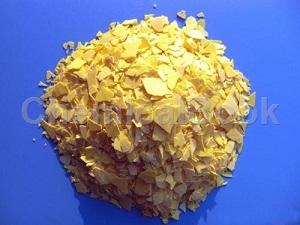Sodium sulfide (Na2S) is a frequently used agent in the flotation of sulfide ores.
Mechanism of action
1. Inhibition mechanism of sulfide ore inhibitors
1. When the concentration of HS- ions reaches a certain value, competitive adsorption occurs on the mineral surface, and HS- ions crowd out the xanthate anions adsorbed on the mineral surface.
2. The hydrophilic HS- ions themselves are adsorbed on the surface of the sulfide ore, which increases the hydrophilicity of the mineral and inhibits the mineral.
3. The solubility product of metal sulfide is smaller than the solubility product of metal xanthate. S2- in the solution undergoes a replacement reaction with xanthate anions, which crowds out the xanthate and is therefore inhibited.

2. Activator for non-ferrous metal oxide ores
After sulfiding the ore surface with Na2S, a sulfide film is formed to activate the minerals, and flotation is carried out with a xanthate collector. Such as the sulfidation reaction of cerussite:
PbCO3]PbCO3+2Na2S=PbCO3]PbS+2Na2CO3
3. Collecting agent for desorbing sulfide ore surface
Since HS- and S2- ions have a strong affinity for sulfide minerals, they can have strong adsorption on the mineral surface. As long as the concentration of these ions in the slurry is large enough, the xanthate adsorbed on the mineral surface can be Desorb.
Main functions
1. Sodium sulfide is an inhibitor of most sulfide minerals
When used in large amounts, it can inhibit the vast majority of sulfide ores. The decreasing order in which it inhibits sulfide minerals is roughly: galena, sphalerite, chalcopyrite, bornite, covellite, pyrite, and chalcocite. Since molybdenite is naturally very buoyant, sodium sulfide cannot inhibit it. Taking advantage of this, when flotating molybdenite, Na2S can be used to suppress other sulfide ores.
2. Sodium sulfide is the sulfiding agent for non-ferrous metal oxide ores
Non-ferrous metal oxide ores cannot be directly collected by xanthate. However, if sodium sulfide is added to react with nonferrous metal oxidized minerals before xanthate flotation, a thin film of sulfide minerals can be produced on the surface of the mineral, and the xanthate can be collected. This effect of sodium sulfide is called sulfidation, so it can be used as a sulfiding agent for non-ferrous metal oxide ores. After the interaction between cerussite and sodium sulfide, the surface color changes from white to dark. After the interaction between malachite and sodium sulfide, the surface color changed from green to dark black, indicating that after sulfide, a sulfide film different from the mineral was formed on the surface of these two minerals.
3. Sodium sulfide is a deagent for sulfide ore mixed concentrate
When sodium sulfide is used in large amounts, it can decompose xanthate collectors on the surface of adsorbed minerals. Therefore, sodium sulfide can be used as a dechemical agent before the separation of mixed concentrates. For example, before sorting lead-zinc mixed concentrate or copper-lead mixed concentrate, the slurry can be concentrated, a large amount of sodium sulfide can be added to remove the chemicals, then washed, fresh water can be added again to mix the slurry, and then separation and flotation can be carried out.
In addition to the above three main functions, because sodium sulfide can form insoluble sulfide precipitation with many metal ions, sodium sulfide can also eliminate certain ions in the slurry that are harmful to flotation.

 微信扫一扫打赏
微信扫一扫打赏

